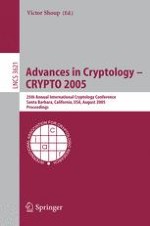2005 | Book
Advances in Cryptology – CRYPTO 2005
25th Annual International Cryptology Conference, Santa Barbara, California, USA, August 14-18, 2005. Proceedings
Editor: Victor Shoup
Publisher: Springer Berlin Heidelberg
Book Series : Lecture Notes in Computer Science
